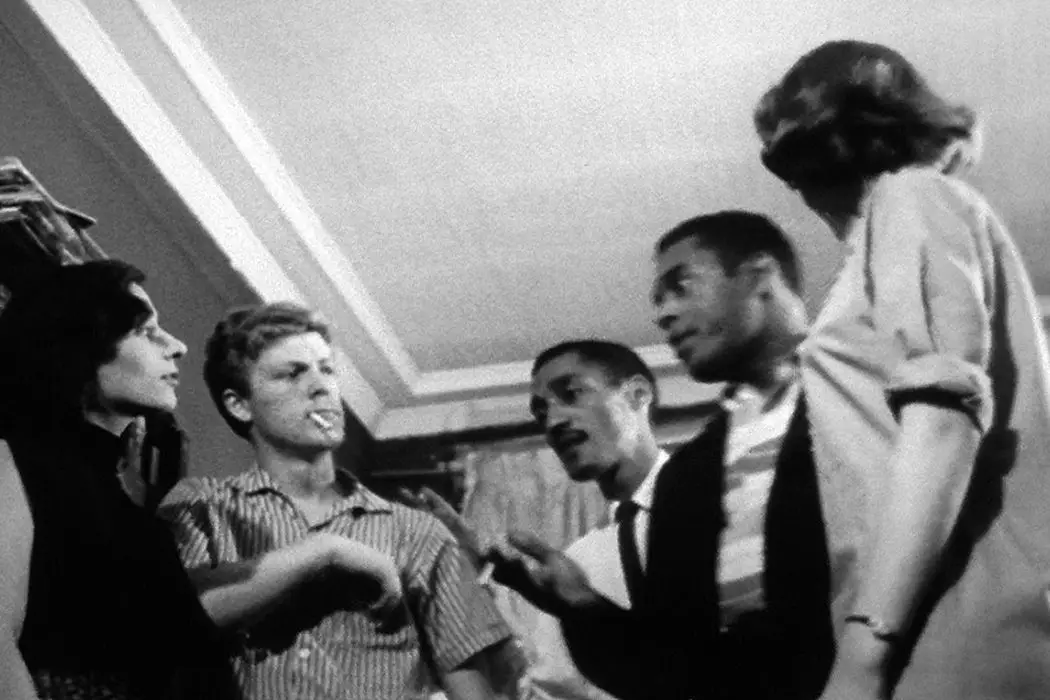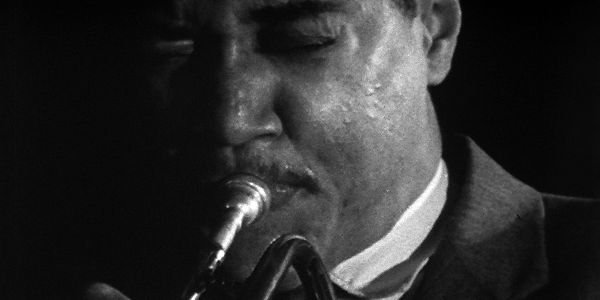The Cry of Jazz: An Invaluable Meditation on Art and Race

Data analyst living in Manchester. Writes for Film Inquiry, The…
“Jazz is dead.” So says The Cry of Jazz. “It cannot grow, it can only repeat itself, and so doing, it is stagnant: and so doing, it dies.”
The Cry of Jazz was first shown in 1959. Confined within a lean thirty-four minutes, the film explains in philosophical language why jazz could have only come from the Black American experience, touching on bohemia, jazz appreciation between races, and how our racial history is embedded in our DNA, inevitably influencing the art that is produced.
With the rhythm and lyricism of spoken word, the narration directs striking scenes of the dire conditions of Chicago areas in the 1950s, intercut with the expressionist, shadow-cut shots of Sun Ra and his band playing the different styles of jazz, as if it’s all under the narrator’s instruction. The Cry is an invaluable meditation on jazz and race, a hybrid of documentary and fiction, where music is celebrated as a purely political construction.
How Square Can You Get?
The initial idea for the film began as a conversation between friends. Edward Bland directed, co-produced, and co-wrote The Cry, but in any description of the production, it’s clear that from the start it was the product of multiple creative minds: they all had a stake in the film’s bold, controversial arguments.

While the framing of the story is simple, it triggers a complex, challenging treatise on the origins of jazz, suggesting how even the basic components of a jazz tune are inherently political, reflecting specifically the Black American struggle. For example, the “endless repetition” and, thus, the “restraining” quality of the rhythm section is akin to “the daily humiliation of American life.” The film then cuts to a sign on an apartment door declaring ‘FOR RENT. WHITES ONLY’.
The Cry of Jazz opens with a scripted discussion taking place at a party between three black men and four white men and women. An argument breaks out when one of the women says to her boyfriend, “Thanks a lot Bruce for showing me how rock and roll is jazz.” Then, out of the corner of the screen, and with the corrective tone of a tutting parent, Alex, the film’s narrator, sweeps in and says, “Did you just tell her that rock and roll is jazz? Bruce, how square can you get?”
What follows is a passionate and unapologetic diatribe about a misunderstanding of jazz in both musical and historical terms. Jazz, the film says, is the one area of American life where the white man is humbled by the black man. And the indignation of the white characters in The Cry reflects how conversations about race play out even today: with bitterness over the assertions that there are unique racial experiences.

The opening scenes are corny and poorly filmed – while being well-written – but the fundamental drive and rigor of the discussion is the essence of its power. When the film dissolves into a visual essay on the cruel living conditions of Black America – where c*ckroaches crawl over a rusty, squalid kitchen as a small child examines the camera’s eye – the film is hypnotic.
The measure of the filmmakers’ craft is betrayed by the opening scenes, but soon the audience can soak-in the streets of Chicago, captured at night from moving cars, as horn solos pierce through the images like the “cries” of its inhabitants.
The justified pessimism of the filmmakers is purposeful, but really the film is a celebration of Black America, where jazz is their “triumph”. In a snide, almost crude swipe at white fetishism of American ‘blackness’, one of the women obsequiously mediates the two opposing sides of the argument and is blatantly motivated by an intense sexual interest in Alex. In this sense, The Cry of Jazz is as much a protest of struggle as it is a bitter howl of pride.
Jazz is Dead?
The story goes that many black intellectuals and artists were not impressed by The Cry, most famously the novelist Ralph Ellison. There are a handful of reasons why the film might have been shunned by those in the creative elite of the 1950s. Both whites and blacks. For some it was the fervent Black Power arguments, soon to rattle America in the following decade and onwards. As it still remains today, sixty years later, it can be hard for people to swallow such indictments of racial injustice.
However, where I imagine many felt most betrayed was in the film’s unwavering conclusion that jazz is dead. In the filmmakers’ eyes, jazz had nowhere to go stylistically, and it was doomed to repeat itself. Any attempt to carry jazz forward would lose the spirit and history of its sound. Edward Bland in 1960 even wrote that anyone who said that jazz was not dead was “musically illiterate”.

The crux of this argument is relayed during a surreal manipulation, where the film skips like a broken record, and the music repeats, quickens, cuts out, then repeats again. Set alight, an abandoned house punctuates the scrambling hands of the pianist trapped in a loop or the horn player unable to make a sound.
But regardless of how well the point is made, 1959 saw the release of a number of seminal jazz albums, not least Miles Davis’s Kind of Blue and Ornette Coleman’s The Shape of Jazz to Come. During the 1960s, free and avant-garde jazz became the next seismic steps in jazz’s evolution, advanced by musicians like John Coltrane, Albert Ayler, Cecil Taylor, and Coleman himself.
Conclusion: The Cry of Jazz
Despite this error, The Cry of Jazz is a significant part of jazz history. A film made by those who loved the music and who were protective of the unbreakable connection that we all feel when certain art shapes the way we live and how we understand ourselves.
The film’s short length is remarkable because, while being astonishingly truthful and poetic, it is a film that wants to fight. Its words are brutal, and its images are bruised – one strikes and the other depicts the battle scars. But The Cry of Jazz does not waste energy or time, and in doing so it succeeds in breaking through with its considerable strength. It remains an inimitable vision of America and the art its people have produced.
Have you seen the film? What are your thoughts on the arguments it makes? Let us know in the comments!
Does content like this matter to you?
Become a Member and support film journalism. Unlock access to all of Film Inquiry`s great articles. Join a community of like-minded readers who are passionate about cinema - get access to our private members Network, give back to independent filmmakers, and more.
Data analyst living in Manchester. Writes for Film Inquiry, The State Of The Arts, Vague Visages.













